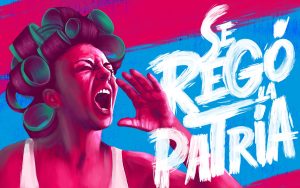Gisabel Leonardo (Spanish and Portuguese) is a 2023–2024 HRI Graduate Fellow. Leonardo’s project, “Melenas Malcriadas: The Black Aesthetics of Hair and Dominicanidad,” uses literature, street art, music, performance, and theory to examine hair as a means of resistance in the contemporary Dominican diaspora.
Learn more about HRI’s Campus Fellowship Program, which supports a cohort of faculty and graduate students through a year of dedicated research and writing in a collaborative, interdisciplinary environment.
What is unique about your research on this topic?
Melenas Malcriadas expands upon ethnographic works that have established hair as a racial signifier in the Dominican racial paradigm. Inspired by my upbringing as a diasporic Dominican woman, my work focuses on a range of creative works that reimagine Dominican hair culture through a Black, feminist, and/or queer lens. I grapple with how the Dominican hair salon mitigates racial anxieties and grooms customers to fit what I call the “national aesthetic imaginary.” This imaginary, which purports a white-mestizo reproductive futurity through miscegenation, is upheld by centuries of colonialism, U.S. imperialism, dictatorship, and anti-Black rhetoric and policy. My project hopes to further nuance these dialogues by engaging with the artistic production of Black and Afro-descendant Dominicans and how they express their relationship with their hair and Dominican hair culture more broadly.
What drives your interest in this research?

One of the motivating forces behind my work is Evaristo Angurria’s Doña Patria murals. I first came across this series in February 2020 during a string of political protests that are still ongoing in the Dominican Republic. As I scrolled through Instagram, I was taken aback by this image of an Afro-Dominican woman yelling at the top of her lungs. What immediately stood out to me was that she was wearing hair rollers, a motif I had been noticing in Dominican visual culture. Her aesthetic of quotidian Afro-Dominican womanhood within the context of national protest encouraged me to think about the insurgent potential of hair.
From that moment, I began noticing these themes in other mediums, including music, literature, and comedy. However, I was simultaneously aware of the ongoing hair-based discrimination Black and Afro-descendant Dominican women faced at school, work, and in their social lives. It became clear to me that the artistic production I was engaging with in my work was offering a counter-imaginary that positioned Blackness and Dominicanness as indelibly intertwined.
How has the fellowship seminar impacted the way you approach your research?
The fellowship seminar has encouraged me to consider other Afro-diasporic racial paradigms that similarly use hair as a racial signifier, therefore strengthening the transnational discourse.

